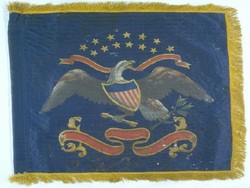

Obverse

US Army Designating
U.S. Cavalry Regimental Standard.
Sub-collection: Howard M. Madaus - Civil War & 19th Century Military CollectionU.S. Cavalry Regimental Standard.
This flag is one of the best examples of American Civil War flags. The field is composed of a dark blue banner silk, edged on three sides with a 2" deep yellow silk fringe. Thirteen stars, gold painted, each 1" across and applied to both the obverse and reverse sides form two arcs (7 over 6) above a full painted rendition of the coat-of-arms of the United States (an eagle with shield on its breast and red scroll for the U.S. motto in its beak). Below the coat-of-arms, a three piece gold edged red scroll is painted to receive the unit abbreviation. The flag was attached to its staff by means of a sleeve, about 2" wide when flat.
The text on the tag reads: "Regimental Cavalry Standard Longley & Brother, Cincinnati Depot contract 1864." It is possible that this flag is an unissued Civil War regulation cavalry standard. Upon issue it was customary to add the regimental abbreviation by painting it on the lower scrolls by the receiving officer.
Longley & Bro. were contracted to make 120 Infantry & artillery colors in 1862 and 235 regimental colors in 1863. They had an 1864 contract to produce 600 cavalry standards (perhaps this example among them), 200 regimental colors, 30 garrison flags and 30 storm flags. Septimius and Servetus Longley were printers in 1861, who quickly converted to flag making during the Civil War. After the war, they returned to the printing business, manufacturing playing cards.
The Howard Michael Madaus sub-collection of Civil War Military Flags was assembled from a variety of sources over a thirty year period of collecting (1970-2000) before being acquired by the Zaricor Collection in 2000. The sub-collection attempts to present an example of each of the major types of depot contractor regulation flags and colors carried by Union forces at the basic unit level, i.e. regiment, battalion, company, and battery, as well as the types of general military flags.
This sub-collection, which was added to the Zaricor Civil War collection, constitutes the largest and (while not complete) most comprehensive collection of the military flags carried by the Union Army during the Civil War outside of state repositories designated by the War Department for the depository of these flags after the War, or in public museum collections. In fact this private collection is larger and more comprehensive than many of the public museum collections in the United States.
ZFC Significant Flag
Item is Framed
Provenance:
• Made by Longley & Brother, Cincinnati, Ohio, 1864.
• Pennsylvania State Fencibles Museum, Philadelphia, PA, until dissolution 1970s.
• Acquired by Mr. Craig Nannos (The Sentry Post) of Broomhall, Pennsylvania, until 1979.
• Conservation work done by Robert D. Needham of Columbus, Ohio
• Sold to Howard M. Madaus of Cody, Wyoming, until 2000.
• Acquired by the Zaricor Flag Collection from the Madaus Flag Collection of Cody, WY, in 2000.
Sources:
Madaus, Howard M.- Whitney Smith, The American Flag: Two Centuries of Concord and Conflict, VZ Publications, Santa Cruz, 2006.
US Army Quartermaster General, Flags of the Army of the United States carried during the War of the Rebellion, 1861-1865, to designate the headquarters of the different armies, army corps, divisions and brigades, Washington, D.C., 1887.
Todd, Frederick P., American Military Equipage 1851-1872, Volume 2, Providence, The Company of Military Historians, 1977.
Woodhead, Henry, ed., Flags, Echoes of Glory: Arms and Equipment of The Union, New York, Time Life Books, 1998,
Madaus, Howard M., correspondence to Ben Zaricor, 29 March 2000, Zaricor Flag Collection Archives.
Image Credits:
Zaricor Flag Collection
CSG
USCS
Hoist & Fly | |
|---|---|
| Width of Hoist | 25.5 |
| Length of Fly | 29.5 |
Stars | |
|---|---|
| Comments on Star Measurements | Gold painted |
Stripes | |
|---|---|
| Size of Hoist | 2 |
Frame | |
|---|---|
| Is it framed? | yes |
| Frame Height | 31 |
| Frame Length | 36 |
Stars | |
|---|---|
| Number of Stars | 13 |
| How are the stars embeded? | Painted |
| Are there stars on obverse? | yes |
| Are there stars on reverse? | yes |
Stripes | |
|---|---|
| Has a Blood Stripe? | no |
Crest/Emblem | |
|---|---|
| Description of Crest/Emblem | Eagle |
Nationality | |
|---|---|
| Nation Represented | United States |
Fabric | |
|---|---|
| Fabric | Silk |
Attachment | |
|---|---|
| Method of Attachment | Sleeve |
Condition | |
|---|---|
| Condition | Fair |
| Damage | Splits in various areas of the field. |
| Displayable | yes |
Date | |
|---|---|
| Date | 1864 |
Exhibits | |
|---|---|
| Exhibition Copy | First Presidio Exhibit (ZFC0412) UNITED STATES ARMY REGIMENTAL CAVALRY STANDARD Date: 1864 Media: Silk; with coat-of-arms and scrolls and stars painted in oil Comment: Due to the expense of maintaining a mounted force, Congress had discontinued the U.S. Cavalry after the War of 1812. It was not revived again until 1833, when a regiment of Dragoons was formed to awe Plains Indians into submission. By 1861 the mounted force of the regular U.S. Army had grown to six regiments, each of which carried a single standard in place of the national and regimental colors authorized for units serving on foot. The cavalry standard was a miniaturized version of the old national standard of the Army. When mounted forces were reauthorized in 1833, the flags carried by infantry and artillery were undergoing a transition with the Stars and Stripes gradually becoming standard for the foot forces. For reasons no longer clear, when those forces were finally all furnished with their national colors by the mid-1840s, the mounted forces need for a similar pair was forgotten. Indeed, the blue standard after 1887, yellow was the only flag carried when a mounted regiment served together until 1895, when the Stars and Stripes was finally granted to the cavalry. Although the Stars and Stripes was not required by the regulations for cavalry flags, during the Civil War many state volunteer units brought them into service. As the War progressed, the Quartermaster Department sought more uniformity for the cavalry, including their flags, and contracts were let with flag-makers accordingly. This flag was one of 600 contracted for in 1864 through Longley & Brother of Cincinnati. While received from the contractor during the War, it was not issued and in 1880 it was declared surplus. Provenance: Acquired by the Zaricor Flag Collection (ZFC0412) in 2000 from the Madaus Flag Collection of Cody, WY; previously part of the State Fencibles Armory Collection of Philadelphia, PA. Second Presidio Exhibit, 2003 - Gallery III (ZFC0412) United States Army Regimental Cavalry Standard Date:1864 Media: Silk; with coat of arms, scrolls, and stars painted in oil Comment: Due to the expense of maintaining a mounted force, Congress had discontinued the U.S. Cavalry after the War of 1812. In 1833, to awe the Plains Indians into submission, Congress raised a new regiment of Dragoons. By 1861 the mounted force of the regular U.S. Army had grown to six regiments, each of which carried a single standard in place of the national and regimental colors authorized for units serving on foot. The cavalry standard was a miniaturized version of the old national standard of the Army. When mounted forces were reauthorized in 1833, the flags carried by infantry and artillery were undergoing a transition and the Stars and Stripes was gradually becoming standard for the foot forces. For reasons no longer clear, when those forces were finally all furnished with their national colors by the mid-1840s, the mounted forces need for a similar pair was forgotten. Indeed, until 1895 the blue standardchanged in 1887 to yellowwas the only flag carried when a mounted regiment served together. In 1895 the Stars and Stripes was finally granted to each regiment of cavalry. This specific flag was one of 600 contracted for in 1864 through Longley & Brother of Cincinnati. While received from the contractor during the War, it was never issued and in 1880 it was declared surplus. Provenance: Acquired by the Zaricor Flag Collection (ZFC0412) in 2000 from the Madaus Flag Collection of Cody, WY; previously part of the State Fencibles Armory Collection of Philadelphia, PA. |
Publications | |
|---|---|
| Publication Copy | Publication History: Madaus, Howard M., Dr, Whitney Smith, The American Flag: Two Centuries of Concord and Conflict. Santa Cruz: VZ Publications, 2006, p. 82. United States Army Regimental Cavalry Standard Due to the expense of maintaining a mounted force, Congress had discontinued the U.S. Cavalry after the War of 1812. In 1833, to awe the Plains Indians into submission, Congress raised a new regiment of Dragoons. By 1861 the mounted force of the regular U.S. Army had grown to six regiments, each of which carried a single standard in place of the national and regimental colors authorized for units serving on foot. The cavalry standard was a miniaturized version of the old national standard of the Army. When mounted forces were reauthorized in 1833, the flags carried by infantry and artillery were undergoing a transition and the Stars & Stripes was gradually becoming standard for the foot forces. For reasons no longer clear, when those forces were finally all furnished with their national colors by the mid-1840s, the mounted forces need for a similar pair was forgotten. Indeed, until 1895 the blue standard changed in 1887 to yellow was the only flag carried when a mounted regiment served together, such as the one shown above from the Civil War. In 1895 the Stars & Stripes was finally granted to each regiment of cavalry. Date: 1864 Size: 25.5" hoist x 29.5" fly Media: Silk; with coat of arms, scrolls, and stars painted in oil Provenance: Acquired by the Zaricor Flag Collection in 2000 from the Madaus Flag Collection of Cody, WY; previously part of the State Fencibles Armory Collection of Philadelphia, PA. ZFC0412 Framed 31" x 36" |
| Publication Images | |
















